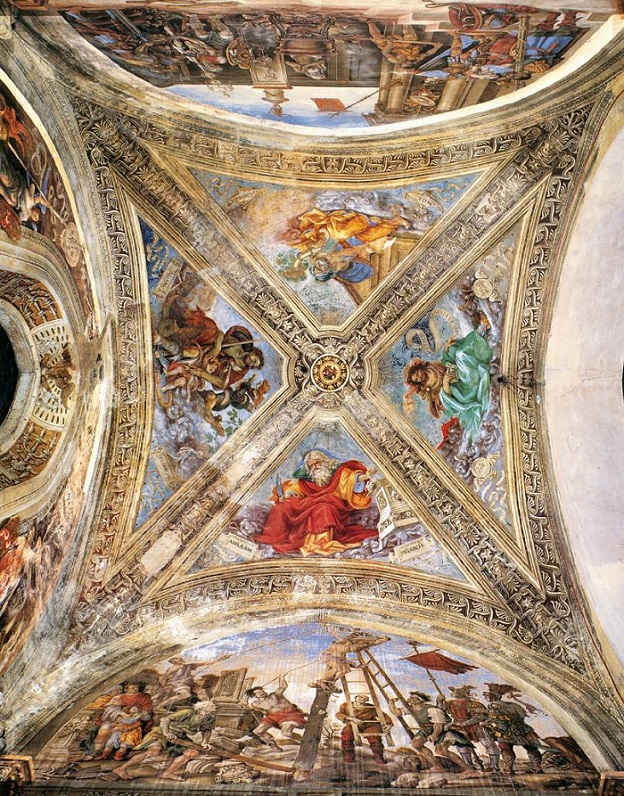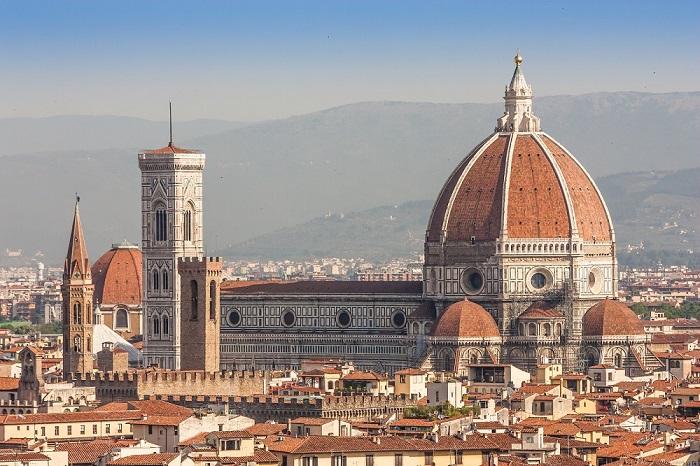By Alexandra Korey
Whether you’ve been to Florence before or you’re planning a return visit, one way to get to know the city’s history and art is through its churches. These were places of social importance but they’re also great architecture. They offer a way to experience painting and sculpture “in situ”, which means in their original location.
There are various orders in which you could face a day spent in Florence’s churches, but I tend to like to do things chronologically so that I can observe the way art changes over time, in order – it’s the art historian in me.
Church of Santa Croce

[Photo, Santa Croce Church, credit: Augusto Mia Battaglia (flickr)]
I always start a visit to Florence at Santa Croce. In part it’s practical: it’s the furthest point from the train station at Santa Maria Novella, so if you are coming in for a day from another Italian city it makes sense. In part, it’s historical: while not the earliest church in Florence, the city’s story of painting, and of the mendicant orders, starts here.
The Franciscan order is a mendicant order of friars that follows the teachings of Saint Francis, who encouraged poverty and preaching. There were Franciscans in Florence in the last decades of the 13th century and they set up just outside the city walls, adjacent to a poor area. They built a small oratory in this location, which eventually grew along with the preachers’ popularity, and led to the construction of the current church starting in 1295, in the Gothic style. (Read more on ArtTrav about the Franciscan order and the early art history of this church.)
The city’s most important banking families were called upon to sponsor the construction and decoration of the chapels in the church, and the Bardi and Peruzzi families are the names associated with two really important ones painted by Giotto, to the right of the high altar. Painted around 1320, Giotto is what we call a proto-Renaissance painter because his style anticipates the naturalism of the Renaissance. The Bardi Chapel is one of the first monumental narratives, telling the story of Saint Francis – make sure you see it! The central chapel is in a more traditional style, and a bit harder to see from below, but the frescoes by Agnolo Gaddi telling the story of the Legend of the True Cross are true masterpieces of the fourteenth century.
There is so much more to visit at Santa Croce, a space that represents layers of history, through the Renaissance Pazzi Chapel to the tombs of Florentine greats… it’s impossible to mention them all here, but I encourage you to take a leisurely visit, possibly helped with an audio guide or with one of the inexpensive tours offered at the ticket desk.
Visitor information: Adult tickets 6€, info at www.santacroceopera.it
Florence Duomo

[Photo Duomo, credit Giuseppe Moscato (flickr)]
From Santa Croce I suggest you walk over to Piazza Duomo. Both buildings were started in the 1290s, and both have facades that were finished in the 19th century (did you know that?). But while the first church belonged to an order, the Duomo or Cathedral is the seat of the Bishop and the most important church in the city. Built on the foundations of an earlier church, it is particularly large, and took over 150 years to finish it. Famous for Brunelleschi’s Dome that topped it during the Renaissance, using innovative engineering solutions, the base of the church is in a rather heavy Gothic style. Inside it is less light and airy than Santa Croce, and less decorated too.
Of course you can’t be in Piazza Duomo without noticing that the church itself is not the only important building here. The Baptistery, Bell-Tower and Duomo make up a tripartite “Duomo Complex” which is something quite typically Tuscan: the other place you see this division of function is in Pisa! The Baptistery is an earlier structure, dating to the 11th century and in what we call the Romanesque style. Romanesque has the word “Roman” in it because it looks kind of like Ancient art in some ways, like how it favours regular geometric shapes, and in fact during the Renaissance they thought this building was ancient. It’s worth the 10 euro cumulative ticket to go inside the Baptistery, which is topped by golden mosaics, the only example of this art in the whole city.
Let’s take a quick look at the other buildings on the piazza that not everyone bothers with! On the right side of the church is the Bell Tower, designed by Giotto, who we just met as a painter but was also a good architect, apparently (hey, the tower is still standing, not bad!). The lower part of the tower is covered in relief sculptures which have been moved into the Museo dell’Opera del Duomo for preservation (closed until Fall 2015, located on the back end of the Duomo). The Palazzo Archivescovile (Bishop’s residence) is behind the Baptistery, reminding us that this was a religious nucleus of the city. There’s also a much overlooked column dedicated to Saint Zenobius that records a 5th-century miracle of a tree flowering in the middle of winter. Finally, framing the entrance to Via Calzaiuoli off Piazza Duomo are two buildings that tell the story of the city’s charitable actions: the Misericordia, still responsible for ambulance services after some 800 years, and the Bigallo, which once helped the lost, and still does, in that it is now a tourist point. Hear a detailed podcast history of Piazza Duomo here.
Visitor information: The Duomo is free to enter, while a cumulative ticket gets you up the Duomo and Belltower, into the Baptistery, and into the Museum when it reopens, for 10€. Info at http://operaduomo.firenze.it/en
Santa Maria Novella

On a clear axis on the other side of the city from Santa Croce is the Basilica or great church of Santa Maria Novella, which was built some 50 years after the Franciscan church by the “competing” mendicant order the Dominicans.
This church is so rich you could easily spend a whole day here. Starting with the outside, this façade is the only one in Florence that was completed during the Renaissance: it is a work by the great architect Leon Battista Alberti from around 1470 while the church dates to the middle of the 14th century. Sit in the newly renovated piazza out front and admire how the architect found a rather genius solution to building on an older structure. The base of the façade was already completed on the Gothic style, so about a hundred years later, wanting to work in a more modern style, Alberti had to figure out how to incorporate this harmoniously into his geometric imposition. See how Alberti squares out the spaces and tries to give the façade logic? And how the top part looks like a Greek temple, with columns and a triangular pediment?

[Photo: Spanish chapel, credit Alexandra Korey]
The modern day entrance to the church is through a ticket office in the back, which will have you enter into a cloister that gives access to spaces originally used by friars. Amongst these is what was called a Chapter House, where friars had their meetings. The one at Santa Maria Novella is also called the Spanish Chapel and it doubled as a burial chapel, fully decorated with frescoes by Andrea di Bonaiuto in the 1360s. The chapel’s complex iconography is intended to show the way to salvation through Christ with the aid of the Dominicans.
The Basilica itself, again in the Gothic style, was built in the mid-14th century, but most of its important decorations and chapels are from a later date. Here are my three favourite, in chronological order. The Strozzi Chapel in the left transept shows scenes of Heaven, the Last Judgement, and Hell on the walls and an important altarpiece in the center, painted by brothers Andrea and Nardo di Cione. The Hell scene is what’s most fun: based on Dante’s concept of a Hell with different levels, despite the fresco’s ruined condition we can make out sinners and their specific sins here. Heaven looks much more boring.

[Photo: Strozzi chapel by Lippi, credit Wikipedia]
In the main apse, on the other hand, is one of the masterpieces of the Early Renaissance, Masaccio’s Trinity. This mysterious fresco has been moved from its original location in the church and we’re not exactly sure where it was first located, something that is relevant because we’d love to know the perfect viewing point for this work. You see, Masaccio was highly concerned with one point perspective, and this work is an early experiment in it. Try walking back from the painting until your eye is at level with the vanishing point to take in the full impact of this work. Another favourite is the Filippo Strozzi Chapel to the right of the high altar, with frescoes by Filippino Lippi started in the late 1480s and completed around 1502. So different from other works in this church and even in Florence, this fresco cycle looks more like something you’d find in Rome (where in fact the artist was working at the time, delaying the completion of the Florentine work). This painting is in the monumental style of the High Renaissance, with elaborate perspective and use of allegory.
Visitor information: Adult tickets cost 5€, see opening hours and more at www.chiesasantamarianovella.it





